Jun 19
Posted: under Activities, Land, photography, Plantlife, Wildlife.
Tags: Activities, beauty, bird behavior, native plants, natural water, photography June 19th, 2016
The rain stopped a week ago; the winter grasses are brown or browning, the early wildflowers have gone to seed. But soil moisture is still good. The tallgrasses (switchgrass, Eastern gama, Indiangrass, big bluestem) are doing very well (switchgrass in the secondary drainage is taller than we are.) There’s an area in the east grass […] [...more]
The rain stopped a week ago; the winter grasses are brown or browning, the early wildflowers have gone to seed. But soil moisture is still good. The tallgrasses (switchgrass, Eastern gama, Indiangrass, big bluestem) are doing very well (switchgrass in the secondary drainage is taller than we are.) There’s an area in the east grass we call “The Bowl” because it’s a roundish area that seeps in wet weather as it slopes down to the old drainage line. It stays green longer. When we got the place, it was covered with broomweed (non-native), bare under the broomweed with a few scattered grass plants, not doing well because of the chemical defense of the broomweek. Today it looks like this:

You can see the upslope edge (pale beige of dry grass)
Every different shade of green, every native plant, reveals something about the soil where it is.
Read the rest of this entry »

Jun 19
Posted: under Activities, Land, photography, Water, Weather, Wildlife.
June 19th, 2016
Earth Day 2016 It had rained in the day before, and dawned cool, with a northeast breeze–a perfect day to go checking the water quality on the east half of the place. Not as much rain as the previous weekend, so with some difficulty I was able to make it from place to place in […] [...more]
It had rained in the day before, and dawned cool, with a northeast breeze–a perfect day to go checking the water quality on the east half of the place. Not as much rain as the previous weekend, so with some difficulty I was able to make it from place to place in ordinary walking shoes. In the distance, the line of woods along the seasonal creek; to the left the “dry woods” growing on a hump of rock. Out of sight to the left, the line of trees along an old ditch dug by a former farmer, intended to carry runoff from the highway to the south property line . A beautiful day, with signs of recovery from the drought…and signs of much management still needed.
Read the rest of this entry »

Feb 10
Posted: under Land, Plantlife, Water.
Tags: beauty, native plants, natural water, photography February 10th, 2010
The upstream part of the dry woods swale, with water seeping through the grass on both sides. This area produces the best water quality, as most of the water has seeped through both rock and soil. [...more]
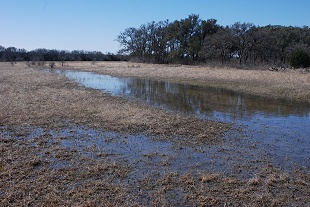
The upstream part of the dry woods swale, with water seeping through the grass on both sides. This area produces the best water quality, as most of the water has seeped through both rock and soil. Read the rest of this entry »

Jan 17
Posted: under Activities, Land, Plantlife, Water, Wildlife.
Tags: Activities, beauty, butterflies, census, new species, photography, Weather January 17th, 2010
We’d had some sprinkles, but the first real rain came Thursday & Friday, about two inches, and set the secondary drainage flowing across the near meadow again. Creek was up and a little turbid, but the flow in the grass was crystal clear. Today, I finally photographed a common (supposedly) species of butterfly around here, […] [...more]
We’d had some sprinkles, but the first real rain came Thursday & Friday, about two inches, and set the secondary drainage flowing across the near meadow again. Creek was up and a little turbid, but the flow in the grass was crystal clear. Today, I finally photographed a common (supposedly) species of butterfly around here, which I’d never been able to catch in the lens.
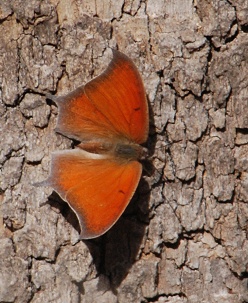 Read the rest of this entry »
Read the rest of this entry »

Sep 18
Posted: under Land, photography, Plantlife, Water.
Tags: beauty, insect, native plants, observation, photography, Weather September 18th, 2009
The water that didn’t run off soaked in; it’s amazing that in one week it’s turned so green. The darker streak in the middle distance is the grass waterway when it rains and right now is just dry enough to walk on in regular shoes. [...more]
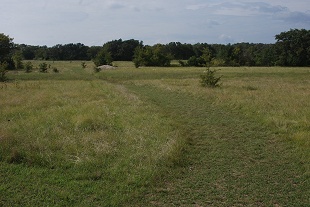
The water that didn’t run off soaked in; it’s amazing that in one week it’s turned so green. The darker streak in the middle distance is the grass waterway when it rains and right now is just dry enough to walk on in regular shoes.
Read the rest of this entry »

Jul 06
Posted: under Land, photography, Weather.
Tags: drought, insect, native plants, photography July 6th, 2009
The near meadow, July 4th…another day of record high temperatures and clear skies with a good strong SW wind. [...more]
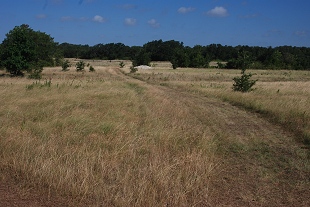
The near meadow, July 4th…another day of record high temperatures and clear skies with a good strong SW wind.
Read the rest of this entry »

Mar 04
Posted: under Land, Plantlife, Weather, Wildlife.
Tags: beauty, native plants, photography, Weather, wildlife management March 4th, 2009
Even in a year this dry, some of the native plants (and a few non-natives) do their best to keep alive and growing. One of the natives we’ve nurtured for years in the yard is the scarlet buckeye, an understory tree that hates sun and drought–but thrives in shady canyons near permanent water. Our version […] [...more]
Even in a year this dry, some of the native plants (and a few non-natives) do their best to keep alive and growing.
One of the natives we’ve nurtured for years in the yard is the scarlet buckeye, an understory tree that hates sun and drought–but thrives in shady canyons near permanent water. Our version of that is the shade of a big old ash and regular watering. I’d like to move its progeny into the creek woods, but right now they’re far too dry (and too far away to water.) It’s just showing its flower buds now; they’ll be open in a few days.
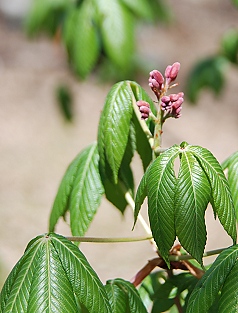
Read the rest of this entry »

Jan 01
Posted: under Activities, Equipment, Land.
Tags: Activities, land management January 1st, 2009
The remnant pocket prairie in the creek woods that we call the “entrance meadow (it’s almost enclosed by woods and is the formal entrance to the thickest part of them) was for the first six years the best seed bank we had of original native plants. Little bluestem, Indiangrass, sideoats grama, Maximilian sunflower, pitcher sage, […] [...more]
The remnant pocket prairie in the creek woods that we call the “entrance meadow (it’s almost enclosed by woods and is the formal entrance to the thickest part of them) was for the first six years the best seed bank we had of original native plants. Little bluestem, Indiangrass, sideoats grama, Maximilian sunflower, pitcher sage, Illinois basketflower, brown-eyed Susan, gayfeather, and others are all found in this small area. Now that we have established other seed-source areas, we’re not as dependent on it, but we still want to maintain it as a pocket prairie, not let it be overgrown with greenbriar, cedar elm, roughleaf dogwood.
So, every winter, I mow it, on the highest setting the small mower can give (the large mower won’t even get into it.) Today was a good day for that, so today I got it done. I don’t try to break down all the tall stalks of the forbs (that takes repeated passes) but do try to knock them about and cut the grass at about 4.5 inches. “About” because it’s not absolutely level. In the scheme of things, this counts as “habitat management.”
On the way back, I mowed one of the work trails (useful for censusing grassland birds, among other things.)
Other work today (some done by R-) included checking all the wildlife waterers and putting out feed for migrant birds. That, of course, falls under “supplemental water” and “supplemental feeding.”

Dec 28
Posted: under Land.
Tags: Add new tag, land management, reporting December 28th, 2008
In Texas, if you have your land recorded with the county tax appraiser as “wildlife management,” which qualified for a lower tax rate on the property, you must have a written plan (based on the seven requirements of the enabling legislation) and submit an annual report on what you’ve actually done to comply with your […] [...more]
In Texas, if you have your land recorded with the county tax appraiser as “wildlife management,” which qualified for a lower tax rate on the property, you must have a written plan (based on the seven requirements of the enabling legislation) and submit an annual report on what you’ve actually done to comply with your plan.
Tax appraisers are out to get the most tax income for their county, so they look with great suspicion on agricultural land, and especially wildlife management land. They have zero interest in wildlife, and are under pressure from county government to provide the money the country wants for roads, bridges, EMS service, county law enforcement, etc. So it’s imperative that the annual report adhere to the legal guidelines for wildlife management and convince them that yes, this is a real project, not a tax shelter.
A previous state comptroller decided that counties must require landowners to use the report form from Texas Parks & Wildlife–the one approved by the legislature and hence not negotiable. This form really fits large properties managing for game animals better than small properties. So I add supporting documentation that adapts the form to a small property.
Read the rest of this entry »

Dec 21
Posted: under Land, Mortality, Wildlife.
December 21st, 2008
In nature, things die. Plants die; animals die; rocks crumble. As a manager, it’s important for me to know what died and have some idea why. If it was a plant was it killed by disease, drought, insect damage, overuse by a native critter? Was it a juvenile, an adult, an aged adult? If it […] [...more]
In nature, things die. Plants die; animals die; rocks crumble. As a manager, it’s important for me to know what died and have some idea why. If it was a plant was it killed by disease, drought, insect damage, overuse by a native critter? Was it a juvenile, an adult, an aged adult? If it was an animal, did some other critter kill it (and if so, as it prey or a rival in a turf dispute?) or did it die of disease or old age or non-natural injury (vehicular injury, gunshot wound, poison, etc.?)
Walking in the creek woods yesterday, I found another set of bones. Both skull and lower jaw, all teeth intact, a shoulder blade, a leg bone (broken, chewed), a rib. As I had other work to do, I brought only the skull back with me, to be sure of species (I’m still learning skull shape–my guess was right, but the dental formula proved it.) Read the rest of this entry »








